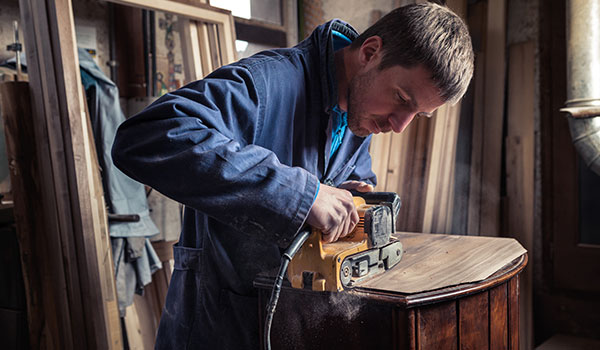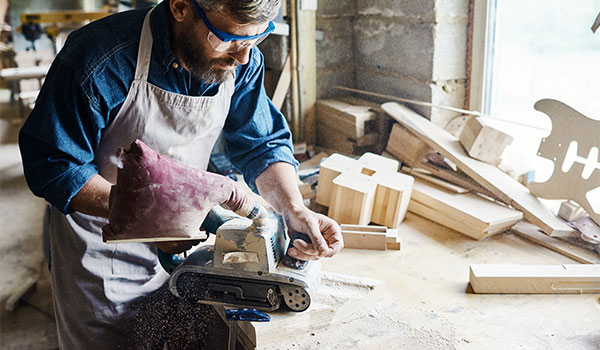The belt sander is a mechanical equipment used in shaping and finishing wood or other materials. A belt sander uses a sandpaper wrapped around two rotating drums which are combined with a disc to smoothen materials and to remove rough patches, stains, and paints. They can either be handheld or stationery with different principles of operation. Handheld sanders are held by hand and moved over the working material surface while stationary sanders are mounted on a bench or table. These sanders function differently when used for woodworking. Check out different types of best performing belt sanders available on the market to know more.
Know About the Belt Sander First
 In order to use the belt sander or any other type of sander effectively, you first need to know how to the tool and get familiar with its different components and functions. This will help you handle the machine efficiently and the avoidance of injury or damaging your furniture.
In order to use the belt sander or any other type of sander effectively, you first need to know how to the tool and get familiar with its different components and functions. This will help you handle the machine efficiently and the avoidance of injury or damaging your furniture.
- Sanding Frame: Sanding frames are accessories which enable the sander to work seamlessly on uneven joint surfaces and guard against gouging and tilting during the sanding operation. When working on delicate surfaces, sanding frames reduce the risk of damage and improves the sander’s stability when sanding wide surfaces.
- Speed Variation: Speed controls make sanders very easy to work with. The Speed dial in a belt sander is for speed adjustments depending on the material being worked on like woodworking, polishing, or veneer removal.
- Set-up: To set up the belt sander you will need to follow the instructions on the owners’ manual to properly set up the Sander. Manufacturers design their sanders differently to suit certain specifications different from others with slightly different setups. If sanders are not properly set up, operating them will prove difficult.
- Build material: For belt sander construction, different materials are used. Though shape and design may differ, some of the common general materials are;
Rubber wheels, nylon ball bearings, drawer slides, nylon and fender washers, knots, glue, spacer wood, plywood, cleats, loctite, epoxy, springs, threads, patio rollers, and bolts. This list is by no means exhaustive but some of the items listed above are general materials used in building one.
Steps to Using a Belt Sander by Hand
 If what you have is a handheld sander, below are a few helpful tips for using it effectively.
If what you have is a handheld sander, below are a few helpful tips for using it effectively.
- Prepare your thing to be sanded: Prepare your wood or whatever material you will work on. Clean it up and ensure it is dust-free. If your sander is a Stationary one, you also need to adjust the position of the work table to a suitable position for you.
- Put on the necessary safety Gear (Googles, gloves, loose-fitting clothes): Protective gears are essential in protecting users from occupational hazards and injuries when working with any type of sanding machine. Goggles are for eye protection if your sander does not have a collection bag. Gloves are to protect the hands from sharp objects/materials and loose-fitting clothes are to protect the body from flying wood shrapnel.
- Turn on the Sander: The sander needs to be at full speed before you start sanding your material. To achieve this, rev up the sander multiple times to ensure it is working properly.
- Let the rear roller contact the wood first: Before you ease the sander into motion, the sander’ rear has to be brought down to touch the material’ surface.
- Ease your sander down with a forward motion by using both hands: Having revved up the sanding machine, ease the sander forward holding the back handle with both hands. This will help you maintain a firm grip. Once the belt rear is on the wood, gently move it forward over the wood piece. Do not stop your hand movement while the sander’ rear is still on the wood surface as this will ruin it.
- Work the Sander with the grain of the wood: Carefully work the edges of the wood with the sander grid until it is as smooth as you want.
- Stop and check the progress frequently: You need to constantly check the material to ensure it is done right. Overdoing it may ruin the shape of the entire piece.
Common Belt Sander Uses
 Belt Sanders are mainly used on wooden furniture though there are some used for other materials other than wood like metal sanders. The belt sander uses its grid to improve material quality. Some belt sander uses are;
Belt Sanders are mainly used on wooden furniture though there are some used for other materials other than wood like metal sanders. The belt sander uses its grid to improve material quality. Some belt sander uses are;
- Refinish wood: Basically, sanders are used on furniture of all sizes and general woodworking. The sandpaper grid can be adjusted to remove coatings and dark stains on wood surfaces.
- Refinish Metal: The same can be done on metals but the kind of grid used for metal finishing differs from the ones used on wood.
- Refinish outdoor furniture: After a long period of usage, wooden furniture lose their color and luster due to wear and tear. Belt sanders can be used to restore the beauty of an old and worn out piece of furniture, making it new again by re-staining and smoothening it to restore its beauty and improve appearance.
- Fix a door that sticks: Another common use is in the fixing of doors. The problem of doors not opening or closing is often experienced by homeowners. To fix doors with a belt sander, you first need to:-
-
- Unhinge the door from its frame: To fit a faulty door, you need to unhinge the door from its frame. Sanding while the door is standing upright will prove difficult in fixing it properly.
- Place it on a flat surface or work deck: The door has to be placed on a flat work deck or surface area so you can easily access the sticking points and door edges.
- Shave the sticking edge of the sander: Place the belt sander on the door edges and gently move over the protruding edges until it is smooth. Be careful not to overdo it lest you ruin its shape and angles.
A sander is a very reliable woodworking tool for restoring shape and beauty to our furniture. They come in different forms like orbital sanders for movement in small circles, belt sanders for straight linear movements and rotary sanders for round movement. Knowing how to use a belt sander shouldn’t be a problem as information can be found in the owner’ manual.
Better understanding and usage will help you in handling your belt sander the right way and the prevention of injuries. Always ensure that the work deck is cleared of obstructive objects and the device is revved up well before use. And if you have not yet purchased your belt sander yet, don’t forget to check out our Top 10 Belt Sander Reviews!










































